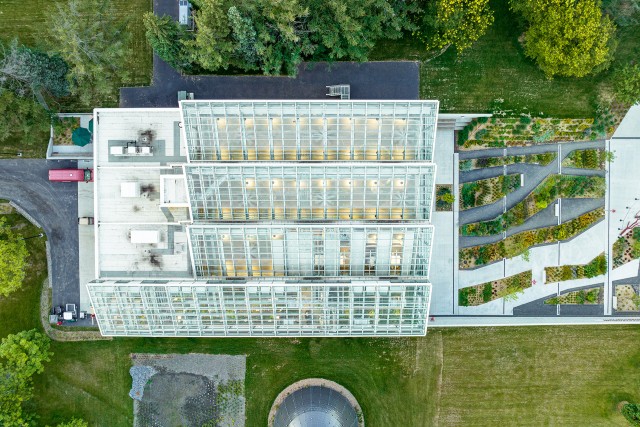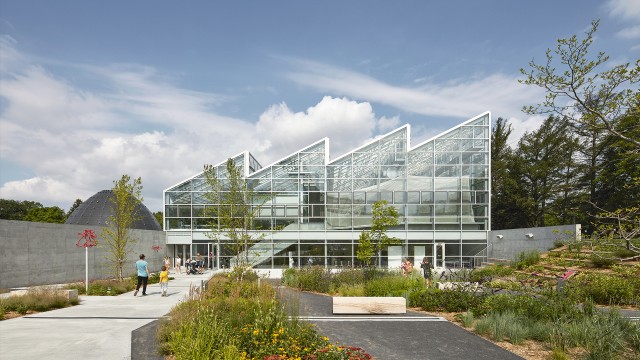The Metamorphosis of the Montréal Insectarium receives LEED Gold certification
We are pleased to announce that the Metamorphosis of the Montréal Insectarium has been awarded LEED Gold certification for new construction (LEED Canada-NC 2009). With a total of 61 points, it is the first building comprising a greenhouse to receive this certification in Quebec. Recall that the project was developed by the multidisciplinary Berlin-Montréal team—Kuehn Malvezzi, Pelletier de Fontenay, Jodoin Lamarre Pratte architectes, Dupras Ledoux, NCK, and atelier le balto—that won the 2014 Space for Life international competition to design the new Insectarium.
Characterized by a unique typology and singular programme, there were few comparable precedents in sustainable development that could inform the project. The main challenge in achieving sustainability targets was designing a building in which the portions above ground are composed almost entirely of greenhouses—which are highly complex and costly environments to regulate. To aim for LEED Gold certification, the new structure had to outperform comparable buildings in terms of energy efficiency.

The sustainable development strategies and objectives integrated into the design process from the outset include:
- optimizing energy performance and integrating all electromechanical systems;
- implementing an automated system with both passive and active energy management;
- optimizing natural ventilation in the greenhouses;
- using natural and artificial lighting efficiently;
- integrating local, sustainable materials with low emissions of volatile organic compounds (VOCs) and recycled materials;
- ensuring responsible water management.
The footprint of the Insectarium and the site plan preserve as many of the Botanical Gardens’ trees as possible. For the greenhouse, a tiered massing is oriented to the south to ensure maximum year-round sun exposure. To ensure good thermal performance, the walls are assembled from sealed units of double glazing with an air space and the roof is composed of laminated double glazing with no air space (interlayer film), which makes snow melt faster and accommodates certain loads. Sophisticated mechanical devices recover much of the heat in the greenhouse and redistribute it to warm the rest of the building during cold periods.
The underground sections take advantage of the thermal mass of the earth to stabilize temperature variations and maximize the building’s insulation. Other complementary systems integrated into the design include textile blinds, motorized shutters, geothermal wells, and rainwater recovery. The latest calculations show that overall, in comparison with a reference building, the Insectarium consumes 30 percent less energy.
Applying, monitoring, and coordinating LEED credits for this project—a truly unique prototype—was a feat: no comparable reference buildings existed; the design was undertaken by an international consortium; the worksite was complex; and so on. We would like to highlight the exemplary work of our architect Joannie Quirion in achieving LEED Gold certification. In collaboration with our partners at CIMA+, she ensured that the credits targeted in the design were respected by carrying out numerous follow-ups during construction.


